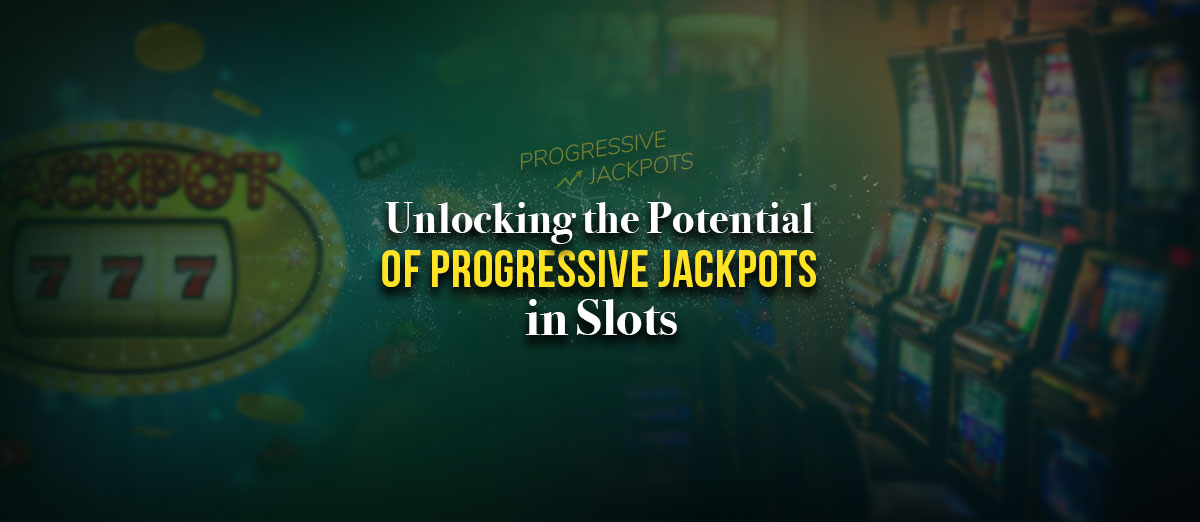Progressive Jackpots Explained - Can You Win Big at Online Slots

Slots are nowadays the most popular casino games, and their popularity evolved with the technology behind the slot machines. It is this technology that allows the diversity of slot games online and all their features, which make the joy of playing slots. In the 1980s, the progressive jackpot was introduced as an extra award, adding to the regular prize schedule of a machine.
In this article, we will see what the progressive jackpot is, how it works and how it can make a slot player a millionaire, as well as whether there is any strategic advice for increasing the chances of winning a progressive jackpot in live casinos.

What Is a Progressive Jackpot?
First, you have to distinguish between the regular jackpot of a slot machine and a progressive jackpot. The regular jackpot is actually the fixed prize (depending only on the size of your bet/credit) having the highest payout odds in the payout schedule of a slot machine.
The progressive jackpot is a variable-increasing prize that is associated with either one or several slot machines. In the latter case, there is a network of slots generating the jackpot called ‘progressives’. The progressive jackpot is continuously accumulating as a prize fund from all the bets placed by the players at the machines in the network. The jackpot is released to one single player by special algorithms and rules for triggering the prize.
Each network has its own progressive system with its own rules and characteristics. As common principles of working: The current amount of the progressive jackpot is displayed on each machine in the network and also in other places in the online or land-based casinos and is called the meter. The contribution to the jackpot fund is made either per bet or per win. Per bet, contribution means that a certain percent of each wager (called the rate of the meter rise) goes to the fund, while per win means that a contribution is directed to the fund only if that bet is winning a regular prize.
The usual rates of the meter rise are 1% and 2%. The progressive jackpot can be released after the meter passes a certain value, called the seed. Each progressive system has its own rules for triggering the jackpot, and the winner is picked with the use of an RNG and complex algorithms between the eligible players.
There are progressive systems requiring a player to win a regular prize (even the regular jackpot) to be eligible for the progressive jackpot. Other systems do not require a win, so any player placing a bet is eligible, but most of them require a maximal bet (credit/denomination) to be placed for the player to be eligible.
The Diverse Landscape of Progressive Jackpots
The progressive jackpot is of two main kinds: unlimited jackpot and must-hit-by jackpot. The unlimited jackpot does not have any limit above which it is released. The release of an unlimited jackpot is only dictated by the algorithms of triggering and the only condition is for the meter to exceed the seed.
The must-hit-by jackpot should be released before an established maximal amount (the must-hit-by value) of the meter is reached. This value is specific to each system. The jackpot can be triggered at any time between the seed and the must-hit-by value. The release point is usually determined by RNG, which picks randomly an amount in that interval between the minimal and maximal value.
With respect to networks, there are three categories of progressives:
- Standalone progressives
These are individual slot machines that accumulate funds for the progressive jackpot only from their own wagers. These were the first progressives in casinos but they are also present today, releasing jackpots of over $10,000.
- Local progressives
In such a network, the progressive jackpot fund is collected from several slot machines within a casino. They are linked in a local network of 10 up to 100 machines. Every player at any machine in the network participates in the jackpot fund, and anyone eligible can win it. It is not uncommon for the local progressives to release jackpots over one million dollars.
- Wide-area network progressives
These are progressives linked in a network across several casinos, online or physical, working in different places all over the globe. The progressive jackpot feeds from the wagers placed at a huge number of machines and may accumulate into millions or tens of millions.
The Biggest Progressive Jackpot Wins in History
Slots players are aware that regular jackpots are very rarely hit, and most of them know that progressive jackpot slots wins are even rarer. Still, they are motivated by the big wins that occurred at progressives over time, which were strongly publicized.
Here are the top 3 progressive jackpots won in the history of slots:
- 1st place: $39.7 million was the biggest slot jackpot of all time, won at Excalibur Casino in Las Vegas. The hit was in 2003 at a Megabucks slot machine.
- 2nd place: $35 million was the second biggest slot jackpot, won at Desert Inn, Las Vegas, in 2000, again at a Megabucks slot machine.
- 3rd place: $27.6 million as the third place was offered by the same Megabucks at Palace Station Casino in Las Vegas in 1998.
This top does not entail that such 8-digit wins are only possible in land-based casinos. Wide-area online network progressives can produce such wins as well and the immediate evidence is just the fourth place at the top of the biggest wins:
€17.8 million jackpot was won online on the website PAF.com in 2013 by a player spinning the reels of a Mega Fortune machine.
Such winning amounts are comparable with the top prizes in state lotteries and since we all know how lucky you should be to hit the jackpot in the lottery, the question arises as to whether progressive slots offer higher chances of winning the jackpot than the lottery does.
Understanding the Chances of Landing a Progressive Jackpot
First of all, you should know that the probability of hitting a progressive jackpot cannot be precisely (not even roughly) estimated. This estimation is impossible first because we don’t know what the algorithm of triggering the jackpot is for either unlimited or must-hit-by progressives – only the developer of the system and the producer know this information.
Moreover, for those systems in which the eligibility criterion is for the player to hit a prize in the regular schedule (usually, the top prize), the probability of hitting the progressive jackpot depends on that latter probability (and is lower than it), which is not computable due to the lack of information regarding the parametric configuration of the slot machine (the number of stops on each reel and the symbol weighting of the reels, information that is kept secret by game’s producer in their PAR sheet).
Despite this lack of information, we still have a general idea about what the order of such probability is. A widely circulated figure on the internet is that of 1 in 50 million as an average, lower than the average probability of winning the jackpot in the state lotteries (for instance, the probability of winning it in the 6/49 lottery is about 1 in 14 million). While I have no idea how they arrived at such a figure as a general mark, I don’t dispute it either. Just as an exercise, let’s do probability estimation for a particular case in idealized conditions:
Assume a 3-reel game with 32 stops on each reel and one top-award symbol on each reel. Assume the game is in a must-hit-by progressive system with meter limits of $1,001 - $3,000, in which the eligibility condition is to hit the regular jackpot associated with the occurrence of the top-award symbol on each reel. Assume also that the algorithm randomly chooses a point for release over a uniform distribution of the integers over the meter range.
The probability of hitting the regular jackpot is (1/32) x (1/32) x (1/32) = 1/32,768. If the player hits the regular jackpot, they will also hit the progressive jackpot only if the meter level updated with that regular win matches the point chosen by the jackpot RNG for release.
We have 2,000 such points in the min-max interval of the meter, so the probability of that match is 1/2,000. Then, the probability of hitting the jackpot (estimated at the moment before any win) is the product of the two probabilities:
P = (1/32,768) x (1/2,000) = 1/65,536,000.

Increasing Your Chances of Winning
It is common knowledge that in regular slots there is no strategic play and the only strategy is that of choosing – а machine, your credit, how many paylines to enable, and even choosing not to play. As for the chances of hitting a prize, the more spins, the higher those chances, like in the lottery, where buying more tickets increases the chances for a lucky draw.
If talking about the chances of winning in terms of hitting the jackpot, the principle above still stands in progressives. The more you play, the higher your chances of hitting the jackpot, although they are minute.
Another factor contributing to the increase of chance is competition. The more players in the network, the lower your chances to hit the jackpot. This is why choosing a small network of progressives and playing in local networks when there is a minimum number of players engaged are recommended.
Of course, the highest jackpots come from wide-area networks; however, the higher the meter level, the more players are attracted to play, so your competition grows, and the chances to hit the jackpot decrease.
Obviously, long-run play and perseverance in sticking with the progressives – required for increasing the chances to hit a jackpot – are dependent upon your bankroll. Therefore, not wasting your bankroll for other purposes is recommended: playing minimum bets if they qualify for the jackpot, not playing them if they do not qualify, and avoiding spending money on other games.
For the per-win progressive system, it is recommended to choose games with lower payout odds, as these are associated with a higher probability of hitting the required regular prize. In the same line of thought, it is recommended to play machines with high RTP and high volatility, if possible, for progressive systems where hitting the regular jackpot is required and with low to medium volatility if other smaller regular prizes are required.
Knowing When to Bet and When to Walk Away
Since hitting a progressive jackpot requires long-run play, we can talk about the chances of winning not only in terms of the probability of hitting but also of expected value.
Progressive jackpots are not only in amounts of millions, as in the top of the big wins, but also lower. Long-run play assumes high cumulated losses (this is why bankroll management is important when chasing a progressive jackpot), and a ‘win’ in the long run actually means a positive overall profit and not necessarily a hit. The only expectation-based strategy in slots is available for must-hit-by progressives:
It is grounded on the principle that the RTP of a machine in such a network increases with the jackpot, and at some point (of the meter level) it will come to exceed 100%, which means zero expectation (and zero house edge); this point is called the breakeven point. After that point, the expected value becomes positive.
The optimal strategy is then to play only when the meter level passes this breakeven point (also called advantage play). This assumes that the player is able to estimate the breakeven point, and the necessary information for the input is the regular RTP of the machine and the rate of the meter rise r. A rule of thumb for roughly determining the breakeven point is the formula:
B = M x (1 – RTP + r) / (1 – RTP + 2r), where M is the must-hit-by value of the jackpot.
The formula is obtained under the assumption that the algorithm triggering the jackpot randomly selects an amount from a uniform distribution of the amounts on the meter range.
For example:
A progressive system with an RTP of 97%, 2% rate r and a must-hit-by value of the jackpot of $4,000 would have the break-even point somewhere near B = $4,000 x (1 – 0.95) / (1 – 0.93) = $2,857.
A player following the expectation-based strategy should play only after the meter reaches this level.
Whatever your strategy in slots, remember that chasing a progressive jackpot is a risky choice since long-run play can deplete your bankroll. In addition, the chances of hitting it remain minute despite any strategy and the luck factor is decisive.
Responsible gambling in slots also assumes getting informed about the progressives and their characteristics before chasing a progressive jackpot.
FAQ
What is a Progressive Jackpot?
A progressive jackpot refers to a special type of casino game prize that grows larger each time a game is played but not won. This jackpot continues to accumulate until a lucky player hits the winning combination.
Upon winning, the jackpot resets to a set starting value and begins increasing again with each play, following the same principle. Progressive jackpots are popular in slots and can offer life-changing sums, making them highly attractive to players seeking big wins. However, they are extremely rare and hard to hit due to the great competition.
How Do You Win a Progressive Jackpot?
To win a progressive jackpot, start by playing a progressive slot game as you would with any slot machine—by placing your bet and spinning the reels. Unlike regular slots, progressive jackpots don't require a special winning combination to hit the jackpot.
Instead, the progressive jackpot is typically triggered at random, offering all players an equal chance of winning regardless of the symbols that appear on the reels. Some games may also offer a bonus game or feature that gives players a chance to win the progressive jackpot, often based on the game's unique mechanics. Remember, betting the maximum amount often increases your chances of triggering the progressive jackpot, though it's essential to play responsibly within your budget.




